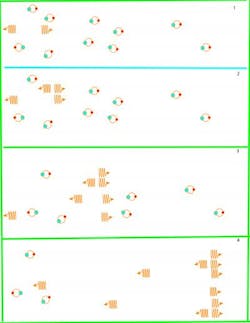
From microwave masers to terahertz, IR, visible, UV, and x-ray lasers, light sources based on gain media cover a wide spectral range. And, in case you ever wondered, gamma-ray lasers may be possible too.
In this blog I will refrain from using Internet-style terms meant to describe fantasy lasers, like "layzor" and "pew-pew-pew," because the word "positronium" beats them all.
As a preliminary, here are two necessary definitions. First, the positronium atom: it is a pair of bound particles, one an ordinary electron and the other the electron's antimatter equivalent, a positron; for a short time they form an object that has many properties similar to those of an ordinary hydrogen atom—and then they annihilate each other completely, releasing gamma radiation.
Second, the Bose-Einstein condensate (BEC), which may be more familiar than positronium to Laser Focus World readers: A BEC is a collection of matter (for those who are physics-oriented, the matter has to be in the form of bosons) laser-cooled to near absolute zero so that most of the particles are in the lowest quantum state. BECs have been used, for example, to slow light, to convert light to matter waves and back to light, and to create atom lasers. BECs can be made of many different kinds of atoms, including positronium.
Triggered by pulsed far-IR radiation
Physicists at the Joint Quantum Institute (JQI), which is based at the University of Maryland (College Park, MD), recently expanded on a twenty-year-old theory1 proposing that a gamma-ray laser emitting photons with a 511 keV energy could be possible using a gain material of a positronium BEC. The JQI theorists defined what configurations are and aren't physically possible for a gamma-ray layzor.2
Their theory accounts for effects of collisions between the two different types of positronium atoms (with electron and positive spins either aligned or antialigned), one of which has a longer lifetime than the other. These collisions put important constraints on gamma-ray laser operation.Without delving into details, we can just state that a positronium BEC must be created and then, between a nanosecond and 0.1 microsecond later, triggered with a pulse of far-infrared radiation with a certain switching sequence, which triggers the "stimulated-annihilation" laser pulse. The lower threshold density for the positronium is likely to be in the range of 1018 positronium atoms per cubic centimeter, which is about 3% of the density of ordinary air; the somewhat larger upper critical density limit is defined by collision processes that destroy the BEC.
Creating such a BEC will likely not be feasible for years to come, and if and when it is done, the resulting gamma-ray device would surely fill a room at least.
One practical result that has already come out of the research at JQI, though: visitors who type "positronium" in the Laser Focus World website's search box will no longer get "Your search did not return any results."
REFERENCES:
1. P. M. Platzman and A.P. Mills, Jr., "Possibilities for Bose condensation of positronium," Physical Review B, Vol. 49, p. 454 (1994).
2. Yi-Hsieh Wang, Brandon M. Anderson, and Charles W. Clark, "Spinor Bose-Einstein Condensates of Positronium," Physical Review A, Vol. 89, p. 043624 (2014), published online 28 April 2014 at http://link.aps.org/doi/10.1103/PhysRevA.89.043624 DOI: 10.1103/PhysRevA.89.043624.
About the Author
John Wallace
Senior Technical Editor (1998-2022)
John Wallace was with Laser Focus World for nearly 25 years, retiring in late June 2022. He obtained a bachelor's degree in mechanical engineering and physics at Rutgers University and a master's in optical engineering at the University of Rochester. Before becoming an editor, John worked as an engineer at RCA, Exxon, Eastman Kodak, and GCA Corporation.

